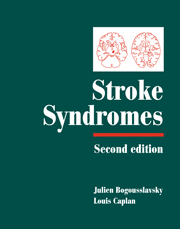Book contents
- Frontmatter
- Contents
- List of contributors
- Preface
- PART I CLINICAL MANIFESTATIONS
- 1 Stroke onset and courses
- 2 Clinical types of transient ischemic attacks
- 3 Hemiparesis and other types of motor weakness
- 4 Sensory abnormality
- 5 Cerebellar ataxia
- 6 Headache: stroke symptoms and signs
- 7 Eye movement abnormalities
- 8 Cerebral visual dysfunction
- 9 Visual symptoms (eye)
- 10 Vestibular syndromes and vertigo
- 11 Auditory disorders in stroke
- 12 Abnormal movements
- 13 Seizures and stroke
- 14 Disturbances of consciousness and sleep–wake functions
- 15 Aphasia and stroke
- 16 Agitation and delirium
- 17 Frontal lobe stroke syndromes
- 18 Memory loss
- 19 Neurobehavioural aspects of deep hemisphere stroke
- 20 Right hemisphere syndromes
- 21 Poststroke dementia
- 22 Disorders of mood behaviour
- 23 Agnosias, apraxias and callosal disconnection syndromes
- 24 Muscle, peripheral nerve and autonomic changes
- 25 Dysarthria
- 26 Dysphagia and aspiration syndromes
- 27 Respiratory dysfunction
- 28 Clinical aspects and correlates of stroke recovery
- PART II VASCULAR TOPOGRAPHIC SYNDROMES
- Index
- Plate section
4 - Sensory abnormality
from PART I - CLINICAL MANIFESTATIONS
Published online by Cambridge University Press: 17 May 2010
- Frontmatter
- Contents
- List of contributors
- Preface
- PART I CLINICAL MANIFESTATIONS
- 1 Stroke onset and courses
- 2 Clinical types of transient ischemic attacks
- 3 Hemiparesis and other types of motor weakness
- 4 Sensory abnormality
- 5 Cerebellar ataxia
- 6 Headache: stroke symptoms and signs
- 7 Eye movement abnormalities
- 8 Cerebral visual dysfunction
- 9 Visual symptoms (eye)
- 10 Vestibular syndromes and vertigo
- 11 Auditory disorders in stroke
- 12 Abnormal movements
- 13 Seizures and stroke
- 14 Disturbances of consciousness and sleep–wake functions
- 15 Aphasia and stroke
- 16 Agitation and delirium
- 17 Frontal lobe stroke syndromes
- 18 Memory loss
- 19 Neurobehavioural aspects of deep hemisphere stroke
- 20 Right hemisphere syndromes
- 21 Poststroke dementia
- 22 Disorders of mood behaviour
- 23 Agnosias, apraxias and callosal disconnection syndromes
- 24 Muscle, peripheral nerve and autonomic changes
- 25 Dysarthria
- 26 Dysphagia and aspiration syndromes
- 27 Respiratory dysfunction
- 28 Clinical aspects and correlates of stroke recovery
- PART II VASCULAR TOPOGRAPHIC SYNDROMES
- Index
- Plate section
Summary
Functional anatomy of somatosensory system
Functional anatomy of the sensory system is briefly discussed here. For further details, readers are referred to previous literature (Woolsey, 1958; Martin & Jessell, 1991; Parent, 1996; Kim, 1998a). There are two functionally and anatomically distinct sensory pathways, the medial lemniscal system and the spinothalamic system (Fig. 4.1). The medial lemniscal system subserves proprioception, vibration, tactile discrimination, and some touch sensations. These fibres ascend at the posterior column of the spinal cord up to the caudal medulla where they synapse on the dorsal column nuclei neurons (nuclei of Goll and Burdach). They then decussate as the internal arcuate fibres and ascend through the opposite medial lemniscus, which is located at the medial portion of the medulla oblongata. The spinothalamic system fibres are responsible for pain and temperature sensations. The peripheral fibres, after entering the dorsal root entry zone, ascend a few segments at Lissauer's tract and then synapse at the dorsal horn. From there, some fibres ascend ipsilaterally, but the majority of the fibres cross the midline in the white commissure and ascend toward the medulla. In the brainstem, the spinothalamic tract is located at the dorso-lateral tegmentum. Some of the spinothalamic fibres are also projected to reticular formations.
The facial (trigeminal) sensations are conveyed to the brainstem through the trigeminal nerves which enter the lateral pons. The fibres carrying touch and tactile discrimination synapse at the principal trigeminal nucleus located in the lateral pons. The secondary fibres (quintothalamic fibres) cross the midline and ascend to the thalamus. The fibres subserving pain and thermal sensations do not synapse at the principal sensory nucleus.
- Type
- Chapter
- Information
- Stroke Syndromes , pp. 34 - 47Publisher: Cambridge University PressPrint publication year: 2001
- 6
- Cited by



